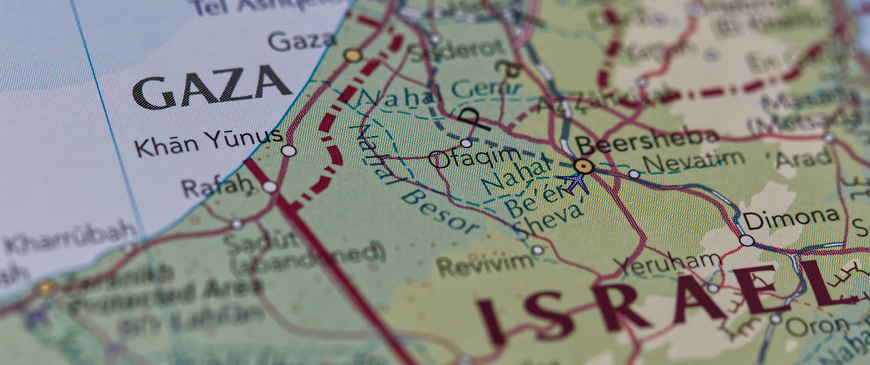In reaction to the mass killings, atrocities, and hostage-taking by Hamas, the Palestinian Islamic Jihad and other militant groups on 7 October 2023, Israel declared war, further tightened the closure of the Gaza Strip, and started a military operation. More than four months into the war, there has been limited progress towards fulfilling Israel’s war aims. At the same time, Gaza’s civilian infrastructure and residential buildings have been largely destroyed, its population has been internally displaced, more than 27,000 Palestinians have been killed, and the humanitarian situation has become ever more horrific. As Israel’s representatives have announced elements of a post-war order, and as military operations are increasingly determining facts on the ground, international actors have also started to engage on the topic of the “day after”. Yet, the interests, priorities, and capabilities of the main protagonists hardly align. Still, the European Union (EU) and its member states should seek to contribute towards ending the war and sustainable stabilisation. Such efforts will have to address governance, security, reconstruction, and a political framework.
The 7 October Hamas-led assault – in which some 1,200 Israelis and foreign nationals were killed and some 240 abducted – seriously diminished Israelis’ sense of personal and collective security, led to the evacuation of almost 220,000 Israelis in the Gaza border communities (and as a result of parallel escalation with Hezbollah) in Israel’s north, and revived collective traumas linked to the Shoah. In reaction, Israel declared war, imposed a complete blockade on the Gaza Strip, and started a military operation that has been unprecedented in scale and impact. Israel’s central war aims, according to Prime Minister Benjamin Netanyahu, have been to retaliate for the attack, to eradicate Hamas (later specified as crushing Hamas’s military and governance capabilities in the Gaza Strip), and to liberate the hostages, of which some 130 remain in the hands of the militants to date. After the war, no more danger was to emanate from Gaza to Israel.
More than four months into the war, Israel, using overwhelming firepower, has killed thousands of militants in Gaza and degraded Hamas’s military capacities. Still, Hamas has maintained the capability to fire rockets at Israel, even from areas in northern Gaza that Israel had declared as cleared, and to stage attacks on Israeli troops operating there. The underground tunnel system, which gives armed groups a crucial tactical advantage in the asymmetric warfare, seems to have remained mostly intact. Also, Hamas leaders have been successful in projecting an upbeat and defiant image. Hamas’s military actions (not the atrocities committed against Israeli civilians, reports of which have been dismissed as propaganda) have been hugely popular among Palestinians, especially in the West Bank. The Hamas narrative, portraying the 7 October events as legitimate resistance, has largely won over populations in the Middle East and large parts of global society.
It has become ever more evident that although the militants’ capabilities can be degraded militarily, time is running out for Israel to completely destroy them. It is also clear that the political and societal influence of Hamas cannot be diminished by military means. To contain the negative impact on its own standing – and despite ideological and political differences – the Palestinian political elite in the West Bank has been careful not to directly condemn Hamas’s actions, but only the violence against civilians in general. Rather, it has stressed that the Islamist movement is part of the Palestinian social and political fabric. What is more, there has been ongoing contact between representatives of Fatah, the ruling faction in the West Bank, and Hamas.
At the same time, Gaza has been devastated in the course of Israel’s military campaign. As of today, most of the civilian infrastructure – partially misused by militant groups for military purposes – has been severely damaged. Almost half of all residential buildings are believed to be beyond repair, leaving about 1 million Gazans homeless. According to the United Nations (UN), 1.7 million people – or around 75 per cent of Gaza’s population – have been internally displaced, many of them repeatedly. They are now mostly crammed into the southernmost part of the Strip, as the focus of fighting has moved to Khan Younis and is about to centre on Rafah. Those evacuating areas of fighting have not found a safe place for refuge. Many lack shelter and basic necessities, including safe drinking water. As of 2 February 2024, at least 27,131 Palestinians have been killed in the Gaza Strip since 7 October, according to the Ministry of Health in Gaza, the statistics of which are considered to be reasonably accurate according to international organisations as well as Israeli intelligence officials. About 70 per cent of those killed are reported to have been women and children. Many more have been declared missing and might still be under the rubble. Hospitals and installations of the UN Relief and Works Agency for Palestine Refugees in the Near East (UNRWA) housing internally displaced persons have come under attack. By late January 2024, more than 150 UN staff had been killed. Gaza’s health and education systems have collapsed. Even though Israel has allowed some humanitarian aid into Gaza via Rafah due to international pressure, it has amounted to far less than what is required to meet the immense need, and little has reached Gaza’s north. Diseases have spread and the UN has warned of the risk of imminent famine.
Read the full analysis at the original link
About the author:
Dr. Muriel Asseburg is a fellow senior for the Africa and Middle East Division. Since 2000, she has had a doctorate in Political Science, Economics and International Law (Dr. rer. pol.) from Ludwig-Maximilians-University Munich


